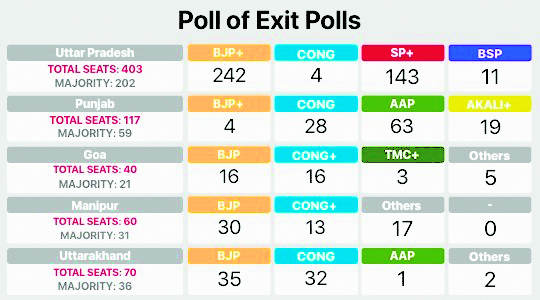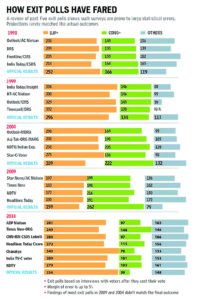
The Election Commission of India (EC) has prohibited announcement of exit poll results for the five poll-bound states till November 30. As per a notification, the EC banned conduct, publication and publicity of exit polls from 7.00 am of November 7 till 6.30 pm of November 30.
The assembly elections in five states — Mizoram, Chhattisgarh, Madhya Pradesh, Rajasthan and Telangana — are being held between November 7 and November 30.
The Election Commission, through its notification, has expressly forbidden the “conducting, publishing, or broadcasting of exit polls via print, electronic media, or any other mode of dissemination” from 7:00 am on November 7, 2023 (Tuesday) until 6:30 pm on November 30, 2023 (Thursday). This notification was issued towards the end of October.
According to a media report, the Election Commision also said that the result of any exit poll in connection with the five elections and assembly by-election in Nagaland shall be prohibited
Moreover, provisions to regulate media coverage of the election are specified under Section 126A of the Representation of the People Act 1951.

While voting for Mizoram, Chhattisgarh and Madhya Pradesh elections are over, polling is due in Rajasthan and Telangana. Rajasthan will go to polls on November 25, while Telangana will vote on November 30.
With the final phase of polling for the 17th Lok Sabha elections ending Sunday, all eyes are now on the much-awaited exit polls. Even as questions about the accuracy of exit polls have been raised over the years, they continue to be watched keenly across the world.
In India, a number of private agencies and media organisations such as Today’s Chanakya, ABP-Cvoter, NewsX-Neta, Republic-Jan Ki Baat, Republic-CVoter, ABP-CSDS, News18-IPSOS, India Today-Axis, Times Now-CNX and Chintamani conduct the exit polls — each claiming to predict the decision of 900 million voters with maximum accuracy.
What are exit polls and how are they conducted?
Exit poll is a post-voting poll conducted just after a voter walks out after casting his or her vote. By contrast, some agencies also carry out post-poll surveys, which refer to a poll of voters taken between the period when the last ballot is cast and when the counting begins. Among the most well-known players in the country, only the Centre for the Study of Developing Societies (CSDS) carries out post-poll surveys.
To conduct an exit poll, a random sample size is first selected. The sample size could range anywhere between 20-25,000 voters to 7-8 lakh voters. While it is not necessary that all 543 constituencies are surveyed in order to accurately predict the results – some agencies could survey as few as half the constituencies – it is important that the sample size is geographically, socially and demographically representative, said Pranav Gupta, a PhD student at University of California at Berkeley.
The number of constituencies and the sample size to be surveyed are typically decided on the basis of the budget available with each agency. The budget can run up to several crores of rupees with each interview of voters costing anywhere between Rs 80-100 to Rs 300-400.
The tricky part – converting vote share into seats
Gathering data from across several constituencies and demographic groups is only a part of the exercise. The other, and perhaps greater challenge is to convert the vote share into seats, said Gupta.
It is this conversion of vote share into seats that sets apart a psephologist from others, including journalists, who may claim to know the “mood of the nation.”
“Seat conversion is hard, but someone with a statistical training could do it,” said Rahul Verma, a fellow at the Centre for Policy Research.
As per the conventional practice, a method called the “uniform regional swing” is applied to convert vote share into seats, he said. For example, if in a certain region, the BJP has a vote share of 35 per cent, and the last time it had a vote share of 38 per cent, on the basis of the number of seats it had won with 38 per cent the last time, one makes an estimate of how many seats it would potentially lose with a loss of vote share of three per cent.
How reliable are exit polls?
Exit polls can often be unreliable.
For example, in 2004 Lok Sabha elections, most exit polls had predicted a victory for the BJP-led National Democratic Alliance (NDA) government. Then in 2009, the exit polls had failed to predict the margin of victory for the United Progressive Alliance (UPA) government correctly. Since then, pollsters have got several state elections wrong.